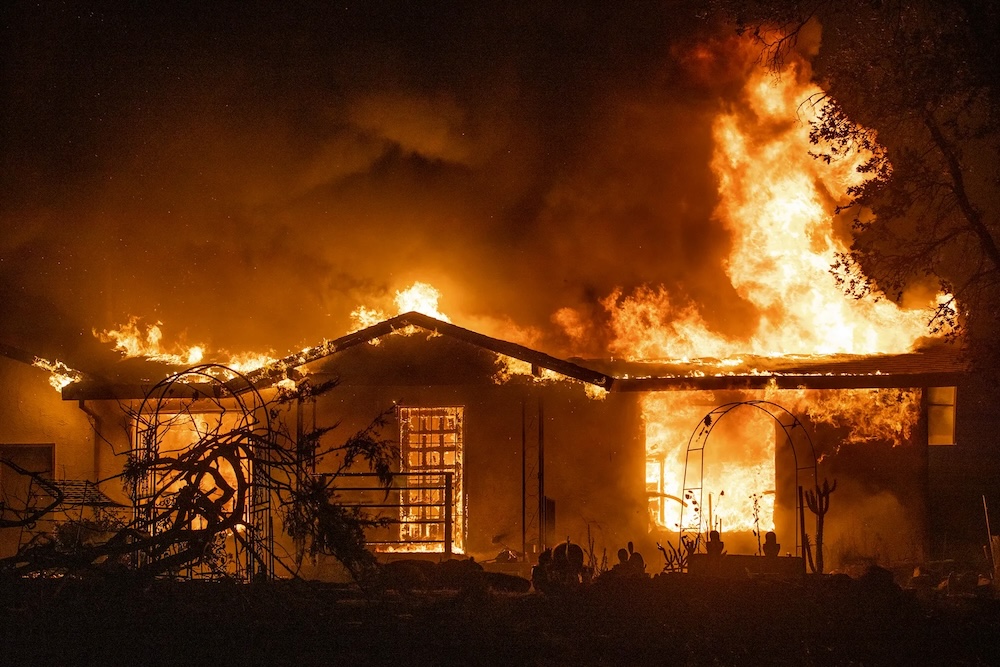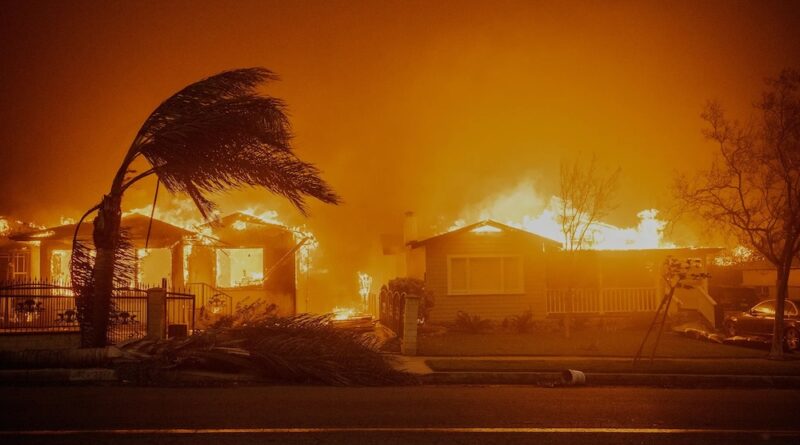Daily Business Report: Jan. 14, 2025
LA fires could drastically drive up insurance
premiums and test California’s new market rules
The state’s plan to fix the insurance crisis had barely
rolled out when the Los Angeles fires began. Can the market recover and stabilize?
By Levi Sumagaysay | CalMatters
The deadly and destructive fires in Los Angeles — which some say could be the costliest in the state’s history — will further strain the insurance market and worsen the financial position of California’s insurer of last resort.
Data about Pacific Palisades, the devastated LA neighborhood whose residents include movie stars and directors, help illustrate the insurance problems plaguing the state. An estimated 1 in 5 homes in the upscale neighborhood were covered by the insurer, known as the FAIR Plan.
Property owners in California have increasingly been turning to the plan, a pool of insurers required by state law to sell fire policies to consumers who can’t find regular insurance elsewhere. That’s because, for the past few years, insurance companies have been canceling policies or refusing to write new ones in California, citing rising risk of wildfires. As a result, the FAIR Plan’s number of homeowner policies grew to more than 451,000 as of September 2024, an increase of 123% over the past three years.
Last year, State Farm decided not to renew tens of thousands of policies in the state, including about 1,600 in Pacific Palisades. As of September, there were 1,430 residential FAIR Plan policies in the enclave’s 90272 ZIP code, an 85% increase from the previous year, according to the plan’s latest data.
Elsewhere in Los Angeles, some cities and neighborhoods with spiking FAIR Plan use have either been evacuated or are near the fires. They include the 90402 ZIP code in Santa Monica, where FAIR Plan policies have increased 128% year over year.
In Pacific Palisades, which has been ravaged by fire over the last few days, there are 1,430 residential policies with the FAIR plan, the state’s insurer of last resort. That’s nearly double the number of plans in 2023.
_________________________________________________________________________________________________________
In Pacific Palisades, which has been ravaged by fire over the last few days, there are 1,430 residential policies with the FAIR plan, the state’s insurer of last resort. That’s nearly double the number of plans in 2023.
The change in the number of plans per ZIP code varies wildly across the state. The number of plans in the Colusa County ZIP code of 95912 went down by 67% while the number of plans in the 91915 ZIP code in San Diego went up by more than 700%.
_________________________________________________________________________________________________________
The change in the number of plans per ZIP code varies wildly across the state. The number of plans in the Colusa County ZIP code of 95912 went down by 67% while the number of plans in the 91915 ZIP code in San Diego went up by more than 700%.
Now, after at least five people have died and more than 2,000 structures have been destroyed in the LA area, and as those who have lost their homes begin to submit claims with their insurance companies, there’s a big question mark around the state’s plan to try to ensure insurance availability. A plan touted by Insurance Commissioner Ricardo Lara as a way to get insurance companies to write policies in the state again just became effective at the beginning of the year.
The so-called sustainable insurance strategy includes having the state speed reviews of rate hike requests from insurance companies and allow insurers to use catastrophe models when setting their premiums. Insurers would also be able to adjust for the cost of their own financial backstop, known as reinsurance. The concessions mean insurers will raise premiums for the state’s property owners but in exchange must write or maintain a certain number of policies in high-risk areas.
“There’s no doubt that this massively complicates things,” said Stephen Collier, professor of city and regional planning at UC Berkeley whose research focuses on insurance, climate change and urban planning. “It couldn’t be at a worse possible time.”
Lara also told CalMatters that “of course this is going to complicate an already complicated market.”
But the commissioner said he has been in touch with insurance companies in the past couple of days: “The reforms are in place now, the (insurers’) commitments are in place now. As far as my conversations as recently as last night, those still stand and move forward.”
In addition, the FAIR Plan, the insurer for many of those affected by the current blazes, will likely have to pay claims for tens of billions of dollars in damages.
Top Photo: The LA fires will have a huge impact on the state’s insurance market, experts said. Trees sway in high winds as the Eaton Fire burns structures in Altadena on Jan. 8, 2025. ( Photo by Ethan Swope, AP Photo)
California pushes insurers to cover more homes in these areas. Is your ZIP included?

Last June, California Insurance Commissioner Ricardo Lara unveiled an effort to force insurers to resume writing policies in high-fire-risk areas — part of an overall plan to address the state’s insurance crisis. It consists of three different ways insurers can meet minimum requirements for writing policies in areas deemed “high risk” or “very high risk” by the department, which aligns with Cal Fire’s identification of hazard zones. Insurance Department regulators said this hybrid approach takes into account the state’s complex geography as well as the different risk levels that big and small insurers can afford to assume. Lara said this should help homeowners who have lost coverage or been forced to turn to the last-resort FAIR Plan.
Insurance companies would have these three options:
- Write 85% of their statewide market share in high-risk areas. The department explains it this way: “If a company writes 20 out of 100 homes statewide, it must write 17 out of 100 homes in a distressed area.”
- Achieve one-time 5% growth in the number of policies they write in high-risk areas.
- Expand their number of policies 5% by taking people out of the strained FAIR Plan,a pool of insurers the state requires to provide fire-insurance policies when property owners can’t obtain insurance elsewhere.
Insurers could meet these policy-writing quotas either at the county level or the ZIP code level. Specifically, they could apply the 85% or 5% option in counties regulators have identified as distressed, or in ZIP codes regulators have deemed “undermarketed” and high risk — meaning the ZIP codes have at least 15% of policies in the FAIR Plan and have a certain percentage of residents who can’t afford their premiums. Insurers who already meet the 85% threshold would be required to maintain that for at least three years after a rate application.
San Diego Regional EDCReports:
VC on the rise again
Ranked a #5 ecosystem for venture capital in the U.S., San Diego startups secured more than $4.37 billion in the first three quarters, up $270 million from 2023, with more to come by year’s end. Top raises include:
- Qualcomm, Intuit Ventures invest in AI startup Anthropic
- Eli Lilly announces $1B partnership with Switzerland and San Diego-based HAYA Therapeutics
- Dexcom announces OURA partnership, $75M Series D
- Carlsbad’s Vuori secures $825M in funding, reaches $5.5B valuation
- Candid Therapeutics debuts with second largest biotech raise at $370M
- Element Biosciences secures more than $277M Series D
- Del Mar’s Kura Oncology, Japanese pharma group Kyowa Kirin ink $1.16B partnership
- Mirador Therapeutics snags San Diego’s largest Q1 VC deal with $400M raise
|
||
|
|
|
||
|
|




